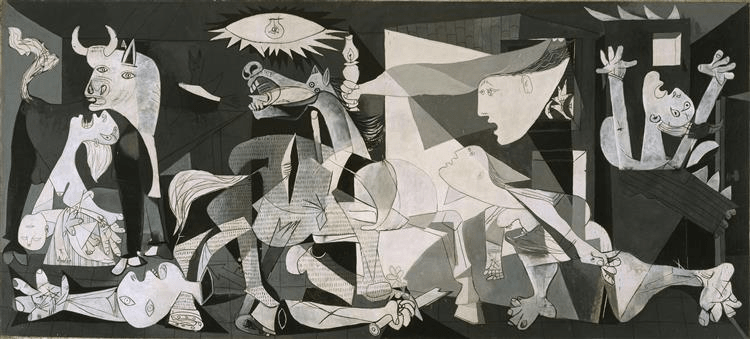Pablo Ruiz Picasso (25 October 1881 – 8 April 1973) was a Spanish painter, sculptor, ceramicist, printmaker, and theater designer. Although he grew up in Spain, he spent most of his adult life in France. As a result, most of Picasso’s drawings and his famous paintings were created in France. In France, he developed the typical Pablo Picasso painting style and started the well-known art movement known as Cubism.
Picasso had extraordinary artistic talent from a young age. In his early years, he painted in a naturalistic manner. In the first decade of the 1900s, he experimented with different theories, techniques, and ideas.
He went through many stages of development, and these different periods can be seen in his artworks. However, his most important period was in the early 1900s, when he initiated what was known as Cubism.
Table of Contents
Picasso and the Beginning of Cubism
Picasso had an African-influenced period from 1907 until 1909. This period was the forerunner of Cubism. His painting “Les Demoiselles d’Avignon” in this period is regarded as the turning point to Cubism.
Les Demoiselles d’Avignon – Pablo Picasso
This painting was shocking both for its content and for its experimentation. The subject of nude women was not unusual at that time. However, the fact that Picasso painted women as prostitutes in sexual postures was new. With his depiction of the faces of the women, he wanted to indicate that sexuality is aggressive as well as primitive.
The painting was broadly thought to be immoral. The artist, Braque, however, studied the painting intently. This led to the Braque-Picasso collaboration. This collaboration and Picasso’s “Les Demoiselles d’Avignon” is regarded as the beginning of Cubism.
Analytic Cubism and Synthetic Cubism: 1909–1919
Pablo Picasso painting style was known as Analytic Cubism. They used monochrome, brownish and neutral colors. Both artists “analyzed” objects in terms of their shapes.
Synthetic Cubism was a further development of Cubism. In this style, the artists cut paper fragments – often wallpaper or portions of newspaper pages – and paste them into their artworks. During this period, Picasso also used collage in his works – a first in the fine arts. Between 1915 and 1917, Picasso painted a series of paintings depicting highly geometric and minimalist Cubist objects.
Basic Points of Departure of Cubist Artists
Let’s look at more detail regarding the Cubist Movement. As mentioned earlier in this article, this new Movement developed after Pablo Picasso had completed his painting Les Demoiselles d’Avignon in 1907. It was a period of experimentation by Pablo Picasso and Georges Braque. They worked with Paul Cezanne’s ideas and his emphasis on the underlying architecture of form.
Cubist artists used multiple points from where they fractured images into geometric forms in their drawings and paintings. For example, figures were depicted as arrangements of volumes and planes in their drawings and paintings. The background and foreground were also merged.
Cubism was one of the most revolutionary art movements of the early-20th century.
It challenged Renaissance ideas and depictions of space. Working in the Cubist style, the artists incorporated collage and popular culture elements into their paintings. They also experimented with sculpture.
Key Ideas and Accomplishments of Cubism
The Cubist artists moved away from perspective, how space was depicted since the Renaissance. They also turned away from realistic figures and explored open form – the piercing of figures and objects to let the space flow through them. They blended the background into the foreground and showed things from various angles. This initial first phase of the Movement was called Analytic Cubism.
In the second phase of Cubism, which was called Synthetic Cubism, the artists explored the use of non-art materials as abstract signs. Their use of newspapers, for instance, are nowadays seen by many art academics not only as experimentation with materials but as a symbol that has been used to indicate their concern about current affairs.
Cubism also put new emphasis on the unity between a depicted scene and the surface of the canvas.
Three Famous Paintings by Picasso in Cubism style
It is appropriate to look at three famous Picasso artworks in his Cubist style to end this article.
“Guernica” is Picasso’s best-known work. It depicts an aerial bombing raid on the Basque town of Guernica during the Spanish Civil War. His use of tones of gray emphasizes the shapes of humans with their arms outstretched in agony. These gray colors give the painting the documentary style of a black-and-white photograph. It also depicts animal imagery associated with Spain, namely the bull and the horse.
“The Weeping Woman” is an oil on canvas painting that depicts Dora Maar, Picasso’s mistress and muse. Nowadays, “The Weeping Woman” is seen as a sequel to “Guernica.” “Guernica” depicts the actual destruction, while “Weeping Woman” looks at the emotional aftermath of war. Picasso created a series of weeping women. The version residing at the Tate — an oil-on-canvas work – is in Picasso’s Cubist angular style.
Guernica – Picasso
“Girl Before a Mirror” is another well-known Cubist painting by Picasso. In the cubist style, this painting is alive with color, pathos, a hint of eroticism, and shapes that take Cubism to its extremes. The artwork asks you what you see when you look at yourself. Picasso, at a stage, said that he preferred this painting to any of his other paintings.
Girl in Front of Mirror – Picasso
The Bottom Line
The following two quotes by Picasso himself give us an insight into his ideas regarding Cubism.
Regarding the philosophy that you only have to paint what you think about, not true objects, he said: “The goal I proposed myself in making Cubism? To paint and nothing more …….. with a method linked only to my thought Neither the good nor the true; neither the useful nor the useless.”
Another one of his quotes regarding reality in his artworks is: “Cubism is not a reality you can take in your hand. It’s more like a perfume, in front of you, behind you, to the sides, the scent is everywhere, but you don’t quite know where it comes from.”
This painting was shocking both for its content and for its experimentation. The subject of nude women was not unusual at that time. However, the fact that Picasso painted women as prostitutes in sexual postures was new. With his depiction of the faces of the women, he wanted to indicate that sexuality is aggressive as well as primitive.
The painting was broadly thought to be immoral. The artist, Braque, however, studied the painting intently. This led to the Braque-Picasso collaboration. This collaboration and Picasso’s “Les Demoiselles d’Avignon” is regarded as the beginning of Cubism.











